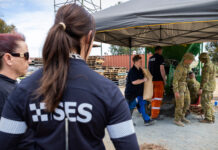
China’s unprecedented deployment of two aircraft carrier groups this summer provided Japanese surveillance aircraft with a wealth of information about the ships, a Japanese official told Breaking Defense, though the People’s Liberation Army — Navy (PLAN) made sure it wasn’t too easy to gather, Breaking Defense reports.
As Japanese Kawasaki P-3C Orions were monitoring the flotilla that included the carriers Liaoning and Shandong in June, the planes were intercepted by PLAN Shenyang J-15 carrierborne fighters several times, according to Japan Maritime Self-Defense Force Capt. Naoto Tabata. Tabata told Breaking Defense that one time the jets came as close as 45 meters (147 feet) from the surveillance birds and on two occasions the planes crossed the nose of the less-manuervable planes.
Though Tabata didn’t say, the move was likely a bid by the PLAN pilot to “thump” — using its wake turbulence to cause a jolt to the intercepted aircraft — the Japanese aircraft.
Regardless of the PLAN’s intimidation, Tabata said the close monitoring of the Chinese exercise enabled Japan to build up a comprehensive picture of the PLAN carriers during their voyage, and enabled the country’s Ministry of Defense to publicize a detailed reportof Liaoning’s and Shandong’s movements between May 25 and late June. Japanese surveillance recorded more than 1,000 aircraft launches and carrier landings.
RELATED: Chinese military ‘directed’ by Beijing to ‘be increasingly provocative,’ Navy official says
The data on the carriers’ movements released by Japan also indicated the Liaoning sailed into the 200 nautical mile (230 mile) EEZ of Minamitori-shima, a Japanese island in the Western Pacific 1,800 km (1,118 miles) southeast of Japan.
“The June deployment was significant as it was the first time China has operated both carriers together, and went beyond the First Island Chain,” Tabata noted.
Tabata spoke during Breaking Defense’s visit to the base of JMSDF’s Fleet Air Wing 5 at Naha on the island of Okinawa early this month. Fleet Air Wing 5 is the southernmost of four operational maritime patrol squadrons of the JMSDF’s aviation arm based along the length of Japan.
“Our mission is the surveillance and information gathering on ships sailing near Okinawa, including the East China Sea. Furthermore, the 5th Air Wing operates aircraft flexibly as needed, maintaining a readiness to respond immediately to various contingencies,” said Tabata.
The recent buildup of China’s nascent carrier force has also meant that JMSDF ships and aircraft have spent more time monitoring the movement and operations of voyages by the People’s Liberation Army Navy (PLAN) aircraft carriers.
OP ED: China’s carriers cruised past the Second Island Chain. What now?
Tabata declined to reveal how many hours the P-3Cs of the unit flew over the last year, although he said they spent at least eight hours on patrol a day, 365 days a year.
According to Tabata, the unit’s aircraft work also closely with the ships and aircraft of the JMSDF and other government agencies such as the Japanese Coast Guard during its routine patrols over waters that have in recent years become a hotbed of Chinese military and coast guard activity, particularly in the waters around the Senkaku islands that are also being claimed by China.
It has also meant that the JMSDF has allocated more assets to patrol the East China Sea, with a map of the patrol areas allocated to the JMSDF’s maritime patrol aircraft shown during a briefing for media showing significant overlap between the East China Sea patrol areas assigned to Fleet Air Wing 5’s P-3Cs and the Kawasaki P-1s of the JMSDF’s Fleet Air Wing 1 based at Kanoya in southern mainland Japan.
The JMSDF is in the process of replacing its turboprop-engined P-3Cs with the jet-powered P-1. It currently has 35 P-1s and 27 P-3Cs in service, according to figures provided to Breaking Defense by the Wing’s public affairs section.
No firm timeline has been set for Naha to receive its first P-1s however, with a training unit currently in the process of converting and Fleet Air Wing 2 at Hachinohe in northern Japan due to receive its P-1s before Naha will start its own transition to the new type, with Japan’s latest Defense White Paper flagging the acquisition of 19 more P-1s in the coming years.


